Envelopes play an essential part in all types of synthesis. We have the details wrapped up and stuck down…
Our ears are amazing yet incongruous organs. We can listen to a symphony orchestra and pick out individual instruments within the melee – something no computer software can do successfully – yet they can be fooled by simple alternatives to complex acoustic sounds. This is fortunate for us otherwise the world of synthesis would be limited to drones and warbles, totally unable to create any realistic sounds.
The ability to fool the ear is particularly important for the third part of our synthesiser building block: tone generation > tone-shaping > volume shaping. Tones are generated with Oscillators and shaped with EQ and filters and now we look at volume shaping which is performed by an envelope generator, also called a contour generator, a transient generator or simply an ADSR after the four phases it produces.
Just a phase
The four phases of a standard ADSR envelope. The main function of an envelope generator is to determine how the volume of a sound should change during its production although it has other uses, too, which we’ll look at in a moment.
The typical envelope generator has four phases – Attack, Decay, Sustain and Release – which, between them, can mimic the sound envelopes of most acoustic instruments.
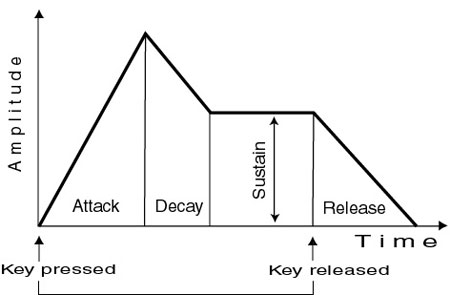
Note that the Attack, Decay and Release phases are a measurement of time while Sustain is a volume level. So we talk about Attack, Decay and Release times but a Sustain level.
The envelope generator is normally triggered when a key is pressed on a synth keyboard and we can get see how the phases fit together by relating them to a keypress.
- Attack This is the time it takes for the sound to reach a certain volume, usually the maximum volume. It begins as soon as you press a key or a note is triggered. Fast Attack times are used for percussive sounds such as drums, piano, guitar and so on, while slower Attack times would be used for strings, brass and a soft flute. Long Attack times are not found on acoustic instruments and tend to be used for electronic sounds and specials effects.
- Decay The Decay phase starts as soon as the Attack phase ends. It’s the time it takes the sound to reach the Sustain level which is normally lower than the volume the Attack phase hits (we’ll look at exceptions in a moment) so the sound usually drops in volume during the Decay phase. For acoustic instruments, the Decay phase is usually longer than the Attack phase.
- Sustain This is the volume level the sound reaches at the end of the Decay phase. There is no specific time period attached to it; it ends when the key is released or the note ends.
- Release When the key is released, the envelope enters the Release phase and this is the time it takes for the sound to die away to silence. Instruments such as a vibraphone and gong have long Release times.
Note that, as its name suggests, the Release phase starts when the key is released. If the envelope is in the middle of the Attack or Decay phase when the key is released, the envelope jumps directly to the Release phase. It does not pass Go or collect £200.
Four more or less
With just these four phases, it’s possible to mimic most natural sounds and acoustic instruments – enough to fool our ears, anyway!
However, not all sounds require all four phases.

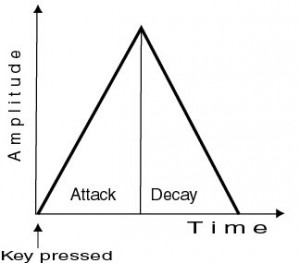
This is a good illustration of the difference between the Decay and Release phases. The Decay phase kicks in immediately after the Attack phase whereas you have to wait for the key to be released before the Release phase starts. The woodblock envelope is totally independent of the length of time the key is held down.
An electronic organ sound has no Decay phase. It hits maximum volume – the Sustain level – as soon as you press a key and stays there until you release the key when it enters the Release phase.
The piano has a more 
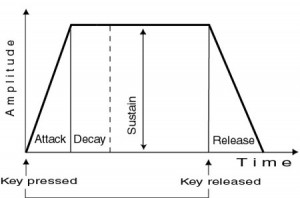
If you hold your finger on the key, the sound dies away slowly; if you release the key it dies away more quickly.
There is no Sustain phase as such. You need a fast Attack, a slow Decay, a faster Release and a zero Sustain level.

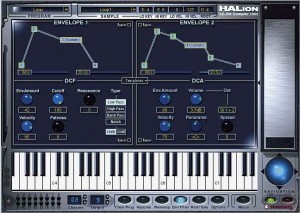
For most acoustic sounds, Attack, Decay and possibly Release times will be measured in milliseconds. However, in the world of synthesis the phases can be several seconds – or minutes! – long.
labmyC
A favourite sound among synthesists has long been the backwards cymbal sound and this has enjoyed a new lease of life in Dance music.
When a normal acoustic sound is produced, something is hit (a drum), stroked (a violin) or otherwise excited (the air inside a brass instrument) and the resulting sound is generated fairly quickly. In other words, it has a relatively fast Attack time. When such a sound ends, it always takes a little while for the sound to fade away completely so there is always a short Decay or Release phase. These sort of envelopes sound natural to us.

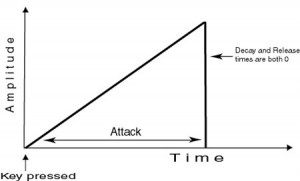
Breaking points
ADSR envelopes were the norm with voltage-controlled analogue synthesisers although there were also variations such as AD (as above) and ADR. As synthesis technology developed it didn’t take long before more complex envelopes were designed.
One variation was to break some of the phases into two sections using what was called a Breakpoint so you might find a ADBDSR envelope. This enables more complex and realistic envelopes to be constructed.
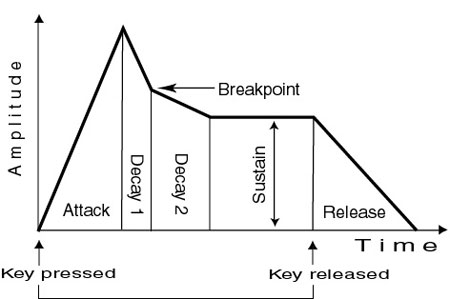
A breakpoint is simply a point at which a change takes place and breakpoints are now commonly used in audio editing software where you can draw a volume or pan envelope onto the signal. You can click breakpoints, sometimes called nodes, onto the envelope line and drag the points to create virtually any envelope contour you wish.
Multi envelopes
As digital technology progressed, the multi-segment envelope appeared. This let you specify both time and volume levels for each stage of the envelope and as most processing was done in cheap software rather more expensive hardware, it was easy to dial up six, eight or more segments according to your desire for complexity.
One feature of multi-segment envelopes is that they allow you to create a contour that rises, falls and then rises again in volume.
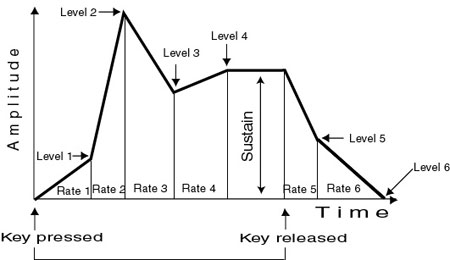
Envelopes and amplifiers
Whatever shape the envelope might be, you won’t hear any sound at all until it’s fed to an amplifier. In a synthesiser, the envelope controls the amplifier so the greater the envelope’s amplitude during any phase, the more the amplifier opens and the louder the output will be.
Modular machinations
Although envelopes are primarily used to shape the volume of a sound, in a modular synthesizer you can connect it to other modules, too.
Tech terms
Inverter
An inverter simply inverts the output signal of a device. Some envelope generators have an inverted output option which produces an inverted envelope shape. These are generally connected to a filter or oscillator rather than an amplifier.
Gate
When a key is pressed and held down, a Gate signal is generated. When applied to an envelope generator, a Gate On message starts the generator which will move through the Attack and Decay phases, staying at the Sustain level until a Gate Off message is produced when the key is released which causes the envelope generator to go into the Release phase.
Transient
This can have several meanings. In recording, it often means a peak or spike in the recorded signal. In synthesis, it means a very short Attack time.
If the cutoff in a low pass filter is closed, all the sound will be filtered out so we start with no sound at all. When the envelope opens the cutoff shoots up creating a bright sound. Then it closes slightly dulling the sound during the Decay phase and it stays at that level until the Release period when the sound gets less bright and finally fades altogether.
Let’s assume we’re using the archetypal ADSR envelope. Let’s see what happens if you apply it to the cutoff control of a low pass filter.
We usually don’t want an envelope to control the harmonics of a sound in such a severe way so filters usually have a control to determine how much of the modulating signal is used. This is a very useful feature because it’s common for the harmonics of an acoustic instrument to change as its volume changes. Brass instruments, for example, generally become brighter as they are played louder.
You can also plug an envelope generator into an oscillator. If you look at the ADSR illustration, you can probably work out what sort of pitch changes the envelope is likely to make. As with filters, an Amount control will reduce the effect from a mad siren to a blip. It can be used to add a slight pitch lift that occurs at the start of many notes in wind and brass instruments, particularly in jazz.
With our Quick Guide series on Oscillators, EQ and Filters and now volume shaping with envelopes, we have covered the essentials of the three basic synthesis building blocks. Putting them all together is the art of the game.
For more info…
Commercial hardware synthesiser sites often have a piece of excellent information about hardware modular synths, including envelope generators:
www.synthesizers.com/q109.html
www.analoguesystems.co.uk/modules/rs60.htm









